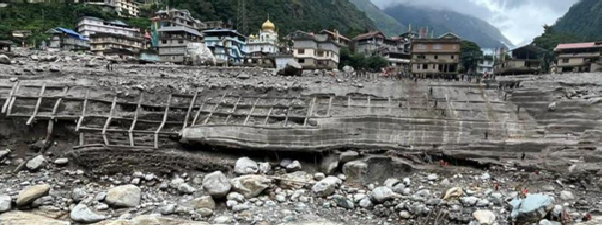
India is seen as disaster prone country . Why? The reasons derive from geographical factors, but also overpopulation. A considerable percentage of the deaths in India is due to natural disasters. However, of all the country have converted what could have been natural disaster into man made disaster.
India witnessed more than 25 deaths in first week of October with many more are missing from a massive flood that resulted from a glacier-lake outburst in Sikkim in the early hours of October 4. The voluminous outflow has destroyed the Chungthang dam, which is critical to the Teesta 3 hydropower project, and rendered several hydropower projects along the river dysfunctional.
Geologist have termed this disaster as Glacier Lake Outburst Flood. Technically, these are instances of large lakes formed from the melting of glaciers, suddenly breaking free of their moraine — natural dams that are formed from rock, sediment and other debris. The South Lhonak glacier, located in north Sikkim, is reportedly one of the fastest retreating glaciers. The glacier receded nearly 2 km in 46 years from 1962 to 2008. It further retreated by ~400 m from 2008 to 2019. There are an estimated 7,500 glaciers in the Himalayas and GLOFs have been associated with major disasters through the years.
An early warning system could have helped authorities evacuate people in time and open the flood gates from dams downstream to minimise damage. However, that was not done! After the Sikkim disaster, India’s National Disaster Management Authority (NDMA) revealed that in early September it had surveyed two at-risk lakes in order to deploy early warning systems for real-time alerts in the event of glacial lake outbursts. One of lakes surveyed was at South Lhonak, where some work for early warnings were initiated. But the flood just weeks later has made people question why there was no functioning early warning system in place already, especially since the lake has long been known to be dangerous.
The most visible consequence of the flooding was the destruction of the Chungthang dam. Though not a storage dam it directs water to power the Teesta 3 hydropower project. The executive chairman of Sikkim Urja, which runs the project, is quoted as saying the dam was “washed away in 10 mins.” Senior officials in the CWC say that the dam is significantly damaged and the quantity of silt and water present made it difficult to estimate the extent of damage. The flood destroyed 11 bridges in the State, with eight bridges getting washed away in the Mangan district alone. Two bridges were destroyed in Namchi and one in Gangtok. Water pipelines, sewage lines and 277 houses have been destroyed in the four most affected districts of Mangan, Gangtok, Pakyong and Namchi. Several studies have over the years warned of the risk from GLOF events from the Himalayas. While the Teesta river is a source of hydropower generation for several power projects, the risk of GLOF like events requires greater care in planning and executing dam and other infrastructure projects, which account for the huge amount of water that can potentially gush through the mountains.
Sikkim is not the only state that has suffered because of the unplanned construction in India. Uttrakhand has witnessed the same, with many towns facing exodus due to sinking hills. The floods in Himachal Pardesh this year affected the residents the more due to unplanned construction than a natural disaster. India need to awake and take a note, that it have had the impact of man made disaster and the states have to be brought on board to keep a better control over construction. Nevertheless, government too has to take care of its infrastructure.







No Comments
Comments for Man made disaster? are now closed.